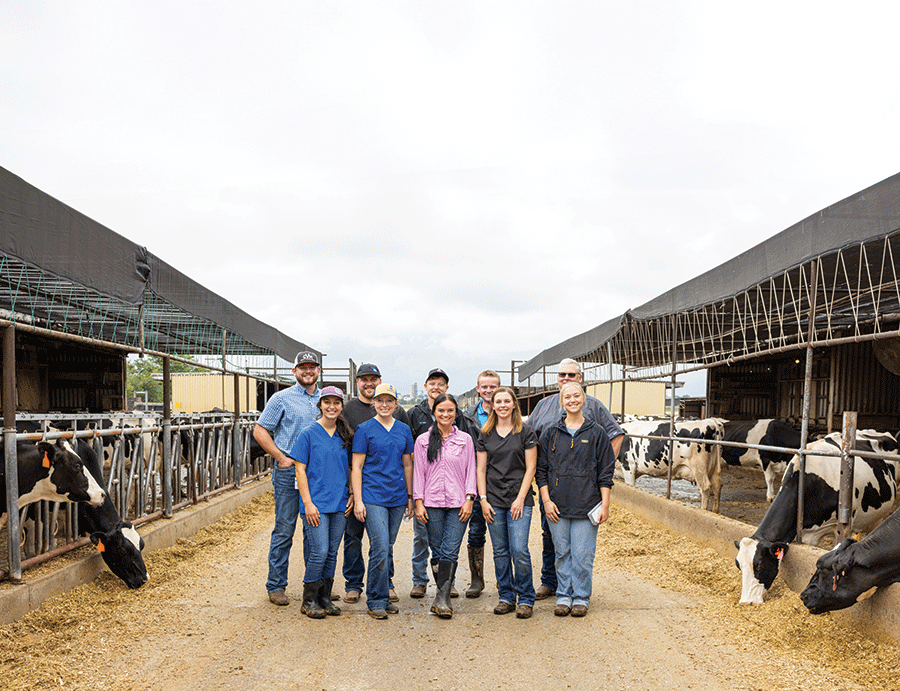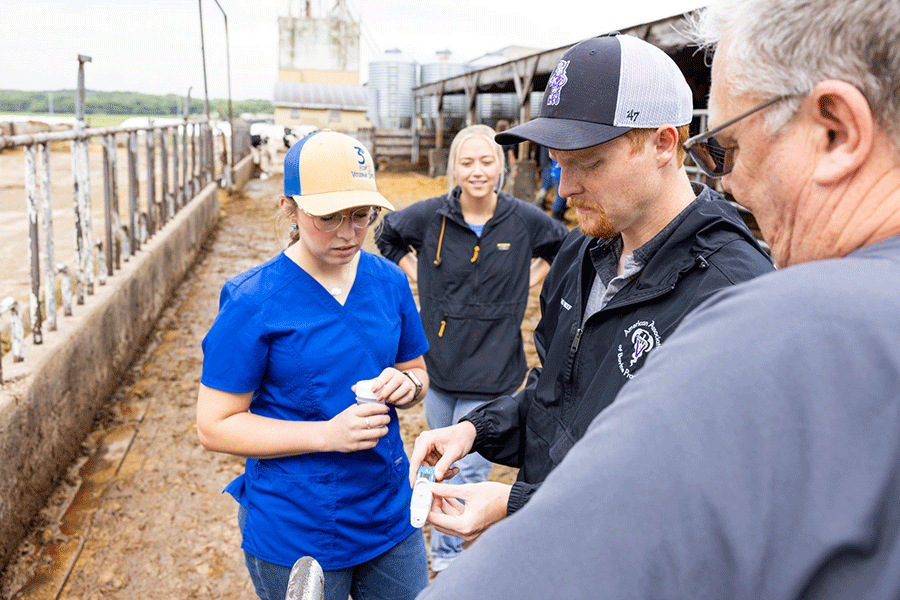Prime Investigation
Veterinary students receive hands-on training in one of the college’s most popular rotational classes.
Story and photos by Audrey Hambright
Photo caption top: Animal handling was another component of the hands-on class. Pictured are third-year students Chance Kopsa, Kailey Beck, Milan Black and Kylynn Mallen.

The Fall 2024 Field Disease Investigation Class pictured at the K-State Dairy Unit. Back row, left to right: Charles Wassberg, Colben Dodson, Carter Claxton, Chance Kopsa and Dr. Gregg Hanzlicek. Front row, left to right: Kailey Beck, Kenzie Jones, Kylynn Mallen, Milan Black and Madalynn Martin.
A field disease investigation class has become a favorite of Veterinary Training Program for Rural Kansas (VTPRK) students – and this should be a good sign for production animal owners in rural Kansas as these future veterinarians will be coming to statistically underserved areas.
The class, taught by Dr. Gregg Hanzlicek, clinical associate professor in diagnostic medicine/pathobiology, was started in 2011. The goal of the class is to teach basic investigation strategies, develop critical thinking skills and hone client communication skills. Approximately 40% of the class is spent in hands-on environments outside, and the other 60% is spent in the classroom.
“It enhances the core veterinary knowledge the students learn and provides exercises to connect classroom knowledge to real world events,” Dr. Hanzlicek says.
He only wishes there was a way to offer it to more students.
The class has evolved a bit, as one might imagine, since it started more than 10 years ago. According to Dr. Hanzlicek, they spend a lot more time developing critical thinking skills.
Once the basics for conducting an investigation are learned, scenarios are provided where the student becomes the practitioner.
“Students have to learn how to talk to clients, collect a meaningful history, formulate appropriate investigation steps,” he says.
The students will also determine if diagnostic tests are needed as well as what sample and how to interpret the test results.
“Finally, at the end of investigation, the student must provide a plan to mitigate the present issue in addition to setting up a program to monitor the success or failure of the practitioner’s mitigation recommendations and, just as importantly, recommend a plan to prevent the health events from occurring in the future,” he adds.
On one particular day in the field, students visited the K-State Dairy Unit where they evaluated feed nutrients to assess the amount of functional fiber in the total mixed rations when rumen acidosis is suspected in a herd. Additionally, they performed urine tests on a group of cows to measure the pH levels. The urine pH is used when investigating herd metabolic issues.

KSU Dairy Unit
Carter Claxton, third-year veterinary student at the K-State College of Veterinary Medicine, who is originally from Oskaloosa, Kansas, chose to take the field disease investigation class this last year. His career goals are focused around the ability to be the most practice ready, rural mixed-animal practitioner he can possibly be coming out of the DVM program.
“I feel as though hands-on, clinically relevant training and experience from long-time practicing veterinarians is invaluable to veterinary students,” Claxton says. “The field investigation course and Dr. Hanzlicek have a reputation of providing this for food-animal focused students.”
Claxton’s favorite part of the course was the hands-on training, such as palpation, liver biopsy, blood draws, and nutrient evaluation from the feed bunk.
“Working on all of these skills, followed up with techniques and strategies to implement them into our own practices someday, was very beneficial,” he says. “The goal of all of this training is to ultimately find ways to provide the highest quality of medicine possible to rural clients, while also finding a way to minimize unnecessary costs that could negatively impact their profit margin and operation goals.”

A set of third-year students in the field disease investigation class evaluate a pH test result. From left, clockwise: Kenzie Jones, Madalynn Martin, Carter Claxton and Dr. Hanzlicek.
Milan Black, a third-year and VTPRK student who took the fall 2024 class, says she was surprised at the wide breadth of topics that were covered during the course.
“We talked a lot about high-risk calves and respiratory disease and then had the opportunity to necropsy calves that fit that classification, she says. “It was helpful to talk about the pathophysiology of disease and then be able to see those changes/lesions in person.”
Black, who is originally from Pratt, Kansas, and plans to serve in a rural mixed-animal practice, says it was very helpful to dive deep into how students can appropriately build vaccination protocols and tailor those protocols to the specific needs of each operation.
“Taking this class has given me a knowledge and skill base to pull from and build upon when I am faced with performing a field investigation in my future career,” she says.